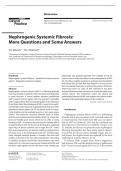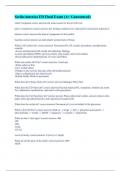Minireview
Nephron Clin Pract 2008;110:c24–c32 Published online: August 7, 2008
DOI: 10.1159/000151228
Nephrogenic Systemic Fibrosis:
More Questions and Some Answers
S.K. Morcos a H.S. Thomsen b
a
Department of Diagnostic Imaging, Northern General Hospital, Sheffield Teaching Hospitals NHS Foundation
Trust, Sheffield, UK; b Department of Diagnostic Radiology, Copenhagen University Hospital, Herlev, and
Department of Diagnostic Sciences, Faculty of Health Sciences, University of Copenhagen, Copenhagen, Denmark
Key Words dodiamide and gadoversetamide. The stability of Gd-CA
Nephrogenic systemic fibrosis ⴢ Gadolinium-based contrast seems to be an important factor in the pathogenesis of NSF.
agents ⴢ Magnetic resonance imaging Gd-CA of low stability are likely to undergo transmetallation
and release free Gd ions that may deposit in tissues and at-
tract circulating fibrocytes to initiate the process of fibrosis.
Abstract There have been no cases of NSF reported in the peer-
Nephrogenic systemic fibrosis (NSF) is a fibrosing disorder reviewed literature after the exclusive use of the stable mac-
that may develop in patients who have advanced reduction rocyclic Gd-CA. This minireview covers the clinical and
in renal function. A causal relation between gadolinium pathological features of NSF and updates the current under-
(Gd3+)-based contrast agents (Gd-CA) and NSF is probable standing of the pathophysiology of this condition.
and is supported by the accumulating data in the literature. Copyright © 2008 S. Karger AG, Basel
From those data, the prevalence of NSF is seen to be signifi-
cantly higher after exposure to gadodiamide than any other
gadolinium-based agent. Gd-CA are either linear or macro- Introduction
cyclic chelates and are available as ionic or non-ionic prepa-
rations. The molecular structure, whether cyclic or linear, Nephrogenic systemic fibrosis (NSF) is a debilitating
and the ionicity determine the stability of Gd-CA. Linear che- disorder that is seen in patients with a marked reduction
lates are flexible open chains which do not offer a strong in renal function. The world’s first NSF case was identi-
binding to Gd3+. In contrast, the macrocyclic chelates offer a fied in 1997 in California, USA, but the condition was
strong binding to Gd3+ by the virtue of being pre-organised first reported in the literature in 2000 by Cowper et al.
rigid rings of almost optimal size to cage the Gd3+ atom. [1]. Initially, the disease was given the name nephrogenic
Non-ionic preparations are also less stable in comparison to fibrosing dermopathy, but later, when reports demon-
the ionic ones, as the binding between Gd3+ and the nega- strated that the disease affects multiple organs and sev-
tively charged carboxyl groups is stronger than that with eral tissues, the original name was replaced by the term
amides or alcohol in the non-ionic preparations. According ‘nephrogenic systemic fibrosis’ [2–4].
to stability constants and kinetic measurements, the most In January 2006, a report from Austria suggested a
stable Gd-CA is the ionic-macrocyclic chelate Gd-DOTA and link between NSF and the administration of gadolinium
the least stable agents are the non-ionic linear chelates ga- (Gd3+)-based contrast agents (Gd-CA) [5]. A few months
© 2008 S. Karger AG, Basel Prof. S.K. Morcos
1660–2110/08/1101–0024$24.50/0 X-Ray Department
Fax +41 61 306 12 34 Northern General Hospital
E-Mail karger@karger.ch Accessible online at: Sheffield S5 7AU (UK)
www.karger.com www.karger.com/nec Tel. +44 114 271 4339, Fax +44 114 261 1791, E-Mail sameh.morcos@sth.nhs.uk
, e n i l n o e l b a l i a va n o i s r e v r o l oC
later, a report from Denmark documented a series of 13
patients who developed NSF following contrast-enhanced
MRI examinations with Gd-CA [6]. Since then, a large
number of reports have appeared in the literature linking
Gd-CA with NSF [7].
This minireview is designed to offer a concise but
comprehensive overview of NSF by answering – accord-
ing to our current state of knowledge – important ques-
tions on this devastating disease.
What Is NSF?
NSF affects mainly patients with end-stage renal dis-
ease, including those on dialysis. It is characterised by the
development of discoloured skin plaques that can be itchy
and painful (fig. 1). The extremities and the trunk are af-
fected but the head and neck are spared, with the excep-
tion of bilateral yellowed scleral plaques. Contractures of
joints and complete loss of range of motion may occur.
The severity of the disease varies from one patient to an-
other and the fibrotic changes can be widespread, possi-
bly affecting other organs such as the liver, lungs, muscles
and heart [4, 8, 9]. In some cases, NSF causes serious Fig. 1. Discoloured skin plaques affecting the feet and legs of a
patient suffering from NSF. Atrophy of the calf muscles is also
physical disability, which can lead to patients requiring a noticeable.
wheelchair. Mortality in patients with multisystem in-
volvement has also been reported [4, 9]. The differential
diagnosis of NSF is presented in table 1 [4].
Table 1. Differential diagnosis of NSF [4]
Pathological Findings Disease Characteristic features that differentiate
Pathological changes seen on routine light micros- the disease from NSF
copy of biopsies of affected skin vary with disease sever-
ity, ranging from subtle changes to marked thickening Lipodermato- Develops in patients who have oedema,
of the dermis. Thick collagen bundles, numerous CD34- sclerosis due to venous insufficiency
Involvement above the knee is rare
positive spindle cells (fibrocytes) and histiocytes are the
prominent histological findings of NSF. Elastic fibres, Scleroderma Auto-antibodies (SCL-70 and anti-
nuclear antibodies)
mucin and elevated tissue levels of transforming growth
Skin changes are seen on the forehead
factor- can also be detected. Calcification in vascular Raynaud disease is a common feature
walls is a common feature. The fibrotic process may ex-
Scleromyxoedema The face is commonly involved
tend through the fascia into the underlying skeletal Frequently associated with multiple
muscle, which becomes atrophic (fig. 1) [3, 4]. Deposits myeloma
of Gd in the skin are not detected by routine histology
Eosinophilic Peripheral eosinophilia is present
stains. fasciitis Underlying polyclonal hypergamma
globulinaemia is common
Chronic graft- Similar to NSF, but the clinical setting is
Is There a Causal Relation between NSF and Gd-CA? versus-host disease characteristic (e.g. after allogeneic stem
cell transplantation)
NSF was not identified before 1997, which suggests
that it is a new disease that is probably due to exposure of
patients with advanced chronic kidney disease (CKD) to
Nephrogenic Systemic Fibrosis Nephron Clin Pract 2008;110:c24–c32 c25





